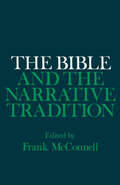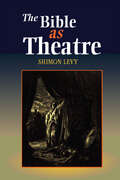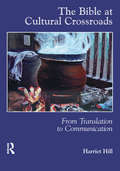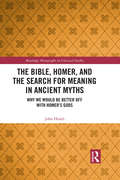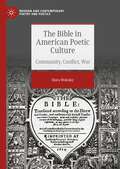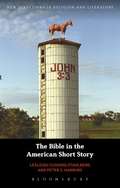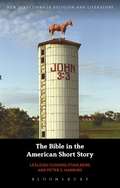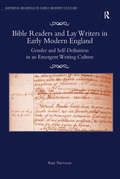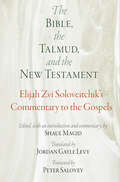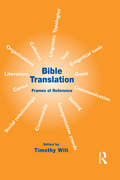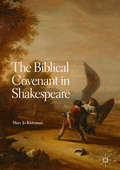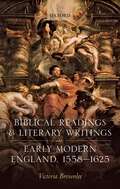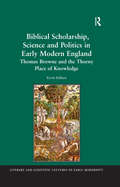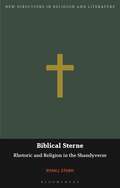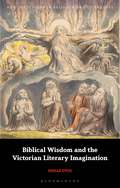- Table View
- List View
The Bible and the Narrative Tradition
Until recently, studies of the Bible centered on finding sources for historical knowledge, theological insights, or ethical advice, overlooking the true beauty of the words in the "book of books." This collection of six essays by noted literary critics and biblical scholars--including Harold Bloom, Hans Frei, Frank Kermode, James Robinson, Donald Foster, and Herbert Schneidau--breaks new ground by exploring the Bible as poetry, rhetoric, and narrative. The authors treat such issues involved in biblical narrative as its genesis, its revisionist dynamic, its fictional character, its interpretive nature, and its contradictions, prejudices, and claims. McConnell's lively, readable introduction elucidates and unifies the book's themes.
The Bible As It Was
by James L. KugelThis is a guide to the Hebrew Bible unlike any other. Leading us chapter by chapter through its most important stories--from the Creation and the Tree of Knowledge through the Exodus from Egypt and the journey to the Promised Land--James Kugel shows how a group of anonymous, ancient interpreters radically transformed the Bible and made it into the book that has come down to us today. Was the snake in the Garden of Eden the devil, or the Garden itself "paradise"? Did Abraham discover monotheism, and was his son Isaac a willing martyr? Not until the ancient interpreters set to work. Poring over every little detail in the Bible's stories, prophecies, and laws, they let their own theological and imaginative inclinations radically transform the Bible's very nature. Their sometimes surprising interpretations soon became the generally accepted meaning. These interpretations, and not the mere words of the text, became the Bible in the time of Jesus and Paul or the rabbis of the Talmud. Drawing on such sources as the Dead Sea Scrolls, ancient Jewish apocrypha, Hellenistic writings, long-lost retellings of Bible stories, and prayers and sermons of the early church and synagogue, Kugel reconstructs the theory and methods of interpretation at the time when the Bible was becoming the bedrock of Judaism and Christianity. Here, for the first time, we can witness all the major transformations of the text and recreate the development of the Bible "As It Was" at the start of the Common era--the Bible as we know it.
The Bible as Theatre
by Shimon LevyA reading of the narrative portions of the Old Testament as dramatic texts.
The Bible as Theatre
by Shimon LevyA reading of the narrative portions of the Old Testament as dramatic texts.
The Bible at Cultural Crossroads: From Translation to Communication
by Harriet HillBible translators have focused their efforts on preparing a text that is clear, natural and accurate, with the expectation that audiences will understand the message if it is in their language. Field research among the Adioukrou of Côte d'Ivoire shows that audiences also need to have access to the contextual information the author expected his audience to bring to the text. When such information is provided, both understanding of and interest in the message increase dramatically. These findings support Relevance Theory's claim that meaning is inferred from the interaction of text and context. To the extent that the contextual knowledge evoked by the text for contemporary audiences differs from that evoked for the first audience, understanding is impaired. The Bible at Cultural Crossroads presents a model to assist translators in identifying contextual mismatches and applies it on the thematic level to mismatches between first-century Jewish and Adioukrou views of the unseen world, and on the passage level to contextual mismatches arising from four Gospel passages. In-text and out-of-text solutions for adjusting contextual mismatches are explored, with field research results showing the effectiveness of various solutions. Context is shown to be both a significant factor in communication and a dynamic one. Translations of the text alone are not sufficient for successful communication.
The Bible at Cultural Crossroads: From Translation to Communication
by Harriet HillBible translators have focused their efforts on preparing a text that is clear, natural and accurate, with the expectation that audiences will understand the message if it is in their language. Field research among the Adioukrou of Côte d'Ivoire shows that audiences also need to have access to the contextual information the author expected his audience to bring to the text. When such information is provided, both understanding of and interest in the message increase dramatically. These findings support Relevance Theory's claim that meaning is inferred from the interaction of text and context. To the extent that the contextual knowledge evoked by the text for contemporary audiences differs from that evoked for the first audience, understanding is impaired. The Bible at Cultural Crossroads presents a model to assist translators in identifying contextual mismatches and applies it on the thematic level to mismatches between first-century Jewish and Adioukrou views of the unseen world, and on the passage level to contextual mismatches arising from four Gospel passages. In-text and out-of-text solutions for adjusting contextual mismatches are explored, with field research results showing the effectiveness of various solutions. Context is shown to be both a significant factor in communication and a dynamic one. Translations of the text alone are not sufficient for successful communication.
The Bible, Homer, and the Search for Meaning in Ancient Myths: Why We Would Be Better Off With Homer’s Gods (Routledge Monographs in Classical Studies)
by John HeathThe Bible, Homer, and the Search for Meaning in Ancient Myths explores and compares the most influential sets of divine myths in Western culture: the Homeric pantheon and Yahweh, the God of the Old Testament. Heath argues that not only does the God of the Old Testament bear a striking resemblance to the Olympians, but also that the Homeric system rejected by the Judeo-Christian tradition offers a better model for the human condition. The universe depicted by Homer and populated by his gods is one that creates a unique and powerful responsibility – almost directly counter to that evoked by the Bible—for humans to discover ethical norms, accept death as a necessary human limit, develop compassion to mitigate a tragic existence, appreciate frankly both the glory and dangers of sex, and embrace and respond courageously to an indifferent universe that was clearly not designed for human dominion. Heath builds on recent work in biblical and classical studies to examine the contemporary value of mythical deities. Judeo-Christian theologians over the millennia have tried to explain away Yahweh’s Olympian nature while dismissing the Homeric deities for the same reason Greek philosophers abandoned them: they don’t live up to preconceptions of what a deity should be. In particular, the Homeric gods are disappointingly plural, anthropomorphic, and amoral (at best). But Heath argues that Homer’s polytheistic apparatus challenges us to live meaningfully without any help from the divine. In other words, to live well in Homer’s tragic world – an insight gleaned by Achilles, the hero of the Iliad – one must live as if there were no gods at all. The Bible, Homer, and the Search for Meaning in Ancient Myths should change the conversation academics in classics, biblical studies, theology and philosophy have – especially between disciplines – about the gods of early Greek epic, while reframing on a more popular level the discussion of the role of ancient myth in shaping a thoughtful life.
The Bible, Homer, and the Search for Meaning in Ancient Myths: Why We Would Be Better Off With Homer’s Gods (Routledge Monographs in Classical Studies)
by John HeathThe Bible, Homer, and the Search for Meaning in Ancient Myths explores and compares the most influential sets of divine myths in Western culture: the Homeric pantheon and Yahweh, the God of the Old Testament. Heath argues that not only does the God of the Old Testament bear a striking resemblance to the Olympians, but also that the Homeric system rejected by the Judeo-Christian tradition offers a better model for the human condition. The universe depicted by Homer and populated by his gods is one that creates a unique and powerful responsibility – almost directly counter to that evoked by the Bible—for humans to discover ethical norms, accept death as a necessary human limit, develop compassion to mitigate a tragic existence, appreciate frankly both the glory and dangers of sex, and embrace and respond courageously to an indifferent universe that was clearly not designed for human dominion. Heath builds on recent work in biblical and classical studies to examine the contemporary value of mythical deities. Judeo-Christian theologians over the millennia have tried to explain away Yahweh’s Olympian nature while dismissing the Homeric deities for the same reason Greek philosophers abandoned them: they don’t live up to preconceptions of what a deity should be. In particular, the Homeric gods are disappointingly plural, anthropomorphic, and amoral (at best). But Heath argues that Homer’s polytheistic apparatus challenges us to live meaningfully without any help from the divine. In other words, to live well in Homer’s tragic world – an insight gleaned by Achilles, the hero of the Iliad – one must live as if there were no gods at all. The Bible, Homer, and the Search for Meaning in Ancient Myths should change the conversation academics in classics, biblical studies, theology and philosophy have – especially between disciplines – about the gods of early Greek epic, while reframing on a more popular level the discussion of the role of ancient myth in shaping a thoughtful life.
The Bible in American Poetic Culture: Community, Conflict, War (Modern and Contemporary Poetry and Poetics)
by Shira WoloskyAlthough the Bible is the foundation of American poetic tradition, there is no study of the Bible as an ongoing force in American poetry. Not only a source of imagery, allusion, rhythm and style, the Bible is central to how poetry has both shaped and been shaped by American civic, political, and social history, including issues of ethnicity, race and gender. Through poetry core issues of the Bible in American culture emerge in a new light. What defines America as a nation? What are its historical, political and religious meanings and direction? Vitally, how is it that the Bible is at once a shared common text, binding community, and yet was throughout American culture also contested, disputed, and politicized as a weapon of war? This study begins with the Puritans, and goes on to examine poetry of the Revolutionary and Civil Wars, as well as claims and counterclaims in abolition, slavery, and women’s rights. In doing so it treats both popular and major writers, including Edward Taylor, Frances Harper, Emerson, Whitman, Dickinson, Moore and Gwendoln Brooks, concluding with Amanda Gorman.
The Bible in the American Short Story (New Directions in Religion and Literature)
by Lesleigh Cushing Stahlberg Peter S. HawkinsThe Bible in the American Short Story examines Biblical influences in the post-World War II American short story. In a series of accessible chapters, Lesleigh Cushing Stahlberg and Peter S. Hawkins offer close-readings of short stories by leading contemporary writers such as Flannery O'Connor, Allegra Goodman, Tobias Wolff and Kirstin Valdez Quade that highlight the biblical passages that they reference. Exploring episodes from the Hebrew Bible and the New Testament and both Jewish and Christian heritages, this book is an important contribution to understanding the influence of the Bible in contemporary literature.
The Bible in the American Short Story (New Directions in Religion and Literature)
by Lesleigh Cushing Stahlberg Peter S. HawkinsThe Bible in the American Short Story examines Biblical influences in the post-World War II American short story. In a series of accessible chapters, Lesleigh Cushing Stahlberg and Peter S. Hawkins offer close-readings of short stories by leading contemporary writers such as Flannery O'Connor, Allegra Goodman, Tobias Wolff and Kirstin Valdez Quade that highlight the biblical passages that they reference. Exploring episodes from the Hebrew Bible and the New Testament and both Jewish and Christian heritages, this book is an important contribution to understanding the influence of the Bible in contemporary literature.
Bible Readers and Lay Writers in Early Modern England: Gender and Self-Definition in an Emergent Writing Culture (Material Readings in Early Modern Culture)
by Kate NarvesonBible Readers and Lay Writers in Early Modern England studies how immersion in the Bible among layfolk gave rise to a non-professional writing culture, one of the first instances of ordinary people taking up the pen as part of their daily lives. Kate Narveson examines the development of the culture, looking at the close connection between reading and writing practices, the influence of gender, and the habit of applying Scripture to personal experience. She explores too the tensions that arose between lay and clergy as layfolk embraced not just the chance to read Scripture but the opportunity to create a written record of their ideas and experiences, acquiring a new control over their spiritual self-definition and a new mode of gaining status in domestic and communal circles. Based on a study of print and manuscript sources from 1580 to 1660, this book begins by analyzing how lay people were taught to read Scripture both through explicit clerical instruction in techniques such as note-taking and collation, and through indirect means such as exposure to sermons, and then how they adapted those techniques to create their own devotional writing. The first part of the book concludes with case studies of three ordinary lay people, Anne Venn, Nehemiah Wallington, and Richard Willis. The second half of the study turns to the question of how gender registers in this lay scripturalist writing, offering extended attention to the little-studied meditations of Grace, Lady Mildmay. Narveson concludes by arguing that by mid-century, despite clerical anxiety, writing was central to lay engagement with Scripture and had moved the center of religious experience beyond the church walls.
Bible Readers and Lay Writers in Early Modern England: Gender and Self-Definition in an Emergent Writing Culture (Material Readings in Early Modern Culture)
by Kate NarvesonBible Readers and Lay Writers in Early Modern England studies how immersion in the Bible among layfolk gave rise to a non-professional writing culture, one of the first instances of ordinary people taking up the pen as part of their daily lives. Kate Narveson examines the development of the culture, looking at the close connection between reading and writing practices, the influence of gender, and the habit of applying Scripture to personal experience. She explores too the tensions that arose between lay and clergy as layfolk embraced not just the chance to read Scripture but the opportunity to create a written record of their ideas and experiences, acquiring a new control over their spiritual self-definition and a new mode of gaining status in domestic and communal circles. Based on a study of print and manuscript sources from 1580 to 1660, this book begins by analyzing how lay people were taught to read Scripture both through explicit clerical instruction in techniques such as note-taking and collation, and through indirect means such as exposure to sermons, and then how they adapted those techniques to create their own devotional writing. The first part of the book concludes with case studies of three ordinary lay people, Anne Venn, Nehemiah Wallington, and Richard Willis. The second half of the study turns to the question of how gender registers in this lay scripturalist writing, offering extended attention to the little-studied meditations of Grace, Lady Mildmay. Narveson concludes by arguing that by mid-century, despite clerical anxiety, writing was central to lay engagement with Scripture and had moved the center of religious experience beyond the church walls.
The Bible, The Talmud, And The New Testament: Elijah Zvi Soloveitchik's Commentary To The Gospels (pdf) (Jewish Culture And Contexts Ser.)
by Shaul Magid Jordan Gayle Levy Peter Salovey Elijah Zvi SoloveitchikBorn in Slutzk, Russia, in 1805, Elijah Zvi Soloveitchik is a largely forgotten member of the prestigious Soloveitchik rabbinic dynasty. Before Hayyim Soloveitchik developed the standard Brisker method of Talmudic study, or Joseph Dov Soloveitchik helped to found American Modern Orthodox Judaism, Elijah Soloveitchik wrote Qol Qore, a rabbinic commentary on the Gospels of Matthew and Mark. Qol Qore drew on classic rabbinic literature, and particularly on the works of Moses Maimonides, to argue for the compatibility of Christianity with Judaism. To this day, it remains the only rabbinic work to embrace the compatibility of Orthodox Judaism and the Christian Bible. In The Bible, the Talmud, and the New Testament, Shaul Magid presents the first-ever English translation of Qol Qore. In his contextualizing introduction, Magid explains that Qol Qore offers a window onto the turbulent historical context of nineteenth-century European Jewry. With violent anti-Semitic activity on the rise in Europe, Elijah Soloveitchik was unique in believing that the roots of anti-Semitism were theological, based on a misunderstanding of the New Testament by both Jews and Christians. His hope was that the Qol Qore, written in Hebrew and translated into French, German, and Polish, would reach Jewish and Christian audiences, urging each to consider the validity of the other's religious principles. In an era characterized by fractious debates between Jewish communities, Elijah Soloveitchik represents a voice that called for radical unity amongst Jews and Christians alike.
Bible Translation: Frames of Reference
by Timothy WiltThis book offers a broad-based, contemporary perspective on Bible translation in terms of academic areas foundational to the endeavor: translation studies, communication theory, linguistics, cultural studies, biblical studies and literary and rhetorical studies. The discussion of each area is geared towards non-specialists, to introduce them to notions, trends and tools that can contribute to their understanding of translation. The Bible translator is encouraged to appreciate various approaches to translation in view of the wide variety of communicative, organizational and sociocultural situations in which translation occurs. However, literary representation of the Scriptures receives special attention since it has been neglected in earlier, influential works on Bible translation. In addition to useful introductory and concluding sections, the book consists of six chapters: Scripture Translation in the Era of Translation Studies; Translation and Communication; The Role of Culture in Communication; Advances in Linguistic Theory and their Relavance to Translation; Biblical Studies and Bible Translation; and A Lterary Approach to Biblical Text Analysis and Translation. The authors are translation consultants for the United Bible Societies. They have worked with translation projects in various media and in languages ranging from ones of a few hundred speakers to international ones, in Africa, the Americas and Asia.
Bible Translation: Frames of Reference
by Timothy WiltThis book offers a broad-based, contemporary perspective on Bible translation in terms of academic areas foundational to the endeavor: translation studies, communication theory, linguistics, cultural studies, biblical studies and literary and rhetorical studies. The discussion of each area is geared towards non-specialists, to introduce them to notions, trends and tools that can contribute to their understanding of translation. The Bible translator is encouraged to appreciate various approaches to translation in view of the wide variety of communicative, organizational and sociocultural situations in which translation occurs. However, literary representation of the Scriptures receives special attention since it has been neglected in earlier, influential works on Bible translation. In addition to useful introductory and concluding sections, the book consists of six chapters: Scripture Translation in the Era of Translation Studies; Translation and Communication; The Role of Culture in Communication; Advances in Linguistic Theory and their Relavance to Translation; Biblical Studies and Bible Translation; and A Lterary Approach to Biblical Text Analysis and Translation. The authors are translation consultants for the United Bible Societies. They have worked with translation projects in various media and in languages ranging from ones of a few hundred speakers to international ones, in Africa, the Americas and Asia.
The Biblical Covenant in Shakespeare
by Mary Jo KietzmanThe theo-political idea of covenant—a sacred binding agreement—formalizes relationships and inaugurates politics in the Hebrew Bible, and it was the most significant revolutionary idea to come out of the Protestant Reformation. Central to sixteenth-century theology, covenant became the cornerstone of the seventeenth-century English Commonweath, evidenced by Parliament’s passage of the Protestation Oath in 1641 which was the “first national covenant against popery and arbitrary government,” followed by the Solemn League and Covenant in 1643. Although there are plenty of books on Shakespeare and religion and Shakespeare and the Bible, no recent critics have recognized how Shakespeare’s plays popularized and spread the covenant idea, making it available for the modern project. By seeding the plays with allusions to biblical covenant stories, Shakespeare not only lends ethical weight to secular lives but develops covenant as the core idea in a civil religion or a founding myth of the early-modern political community, writ small (family and friendship) and large (business and state). Playhouse relationships, especially those between actors and audiences, were also understood through the covenant model, which lent ethical shading to the convention of direct address. Revealing covenant as the biblical beating heart of Shakespeare’s drama, this book helps to explain how the plays provide a smooth transition into secular society based on the idea of social contract.
The Biblical Covenant in Shakespeare
by Mary Jo KietzmanThe theo-political idea of covenant—a sacred binding agreement—formalizes relationships and inaugurates politics in the Hebrew Bible, and it was the most significant revolutionary idea to come out of the Protestant Reformation. Central to sixteenth-century theology, covenant became the cornerstone of the seventeenth-century English Commonweath, evidenced by Parliament’s passage of the Protestation Oath in 1641 which was the “first national covenant against popery and arbitrary government,” followed by the Solemn League and Covenant in 1643. Although there are plenty of books on Shakespeare and religion and Shakespeare and the Bible, no recent critics have recognized how Shakespeare’s plays popularized and spread the covenant idea, making it available for the modern project. By seeding the plays with allusions to biblical covenant stories, Shakespeare not only lends ethical weight to secular lives but develops covenant as the core idea in a civil religion or a founding myth of the early-modern political community, writ small (family and friendship) and large (business and state). Playhouse relationships, especially those between actors and audiences, were also understood through the covenant model, which lent ethical shading to the convention of direct address. Revealing covenant as the biblical beating heart of Shakespeare’s drama, this book helps to explain how the plays provide a smooth transition into secular society based on the idea of social contract.
Biblical Readings and Literary Writings in Early Modern England, 1558-1625
by Victoria BrownleeThe Bible had a profound impact on early modern culture, and bible-reading shaped the period's drama, poetry, and life-writings, as well as sermons and biblical commentaries. This volume provides an account of the how the Bible was read and applied in early modern England. It maps the connection between these readings and various forms of writing and argues that literary writings bear the hallmarks of the period's dominant exegetical practices, and do interpretative work. Tracing the impact of biblical reading across a range of genres and writers, the discussion demonstrates that literary reimaginings of, and allusions to, the Bible were common, varied, and ideologically evocative. The book explores how a series of popularly interpreted biblical narratives were recapitulated in the work of a diverse selection of writers, some of whom remain relatively unknown. In early modern England, the figures of Solomon, Job, and Christ's mother, Mary, and the books of Song of Songs and Revelation, are enmeshed in different ways with contemporary concerns, and their usage illustrates how the Bible's narratives could be turned to a fascinating array of debates. In showing the multifarious contexts in which biblical narratives were deployed, this book argues that Protestant interpretative practices contribute to, and problematize, literary constructions of a range of theological, political, and social debates.
Biblical Readings and Literary Writings in Early Modern England, 1558-1625
by Victoria BrownleeThe Bible had a profound impact on early modern culture, and bible-reading shaped the period's drama, poetry, and life-writings, as well as sermons and biblical commentaries. This volume provides an account of the how the Bible was read and applied in early modern England. It maps the connection between these readings and various forms of writing and argues that literary writings bear the hallmarks of the period's dominant exegetical practices, and do interpretative work. Tracing the impact of biblical reading across a range of genres and writers, the discussion demonstrates that literary reimaginings of, and allusions to, the Bible were common, varied, and ideologically evocative. The book explores how a series of popularly interpreted biblical narratives were recapitulated in the work of a diverse selection of writers, some of whom remain relatively unknown. In early modern England, the figures of Solomon, Job, and Christ's mother, Mary, and the books of Song of Songs and Revelation, are enmeshed in different ways with contemporary concerns, and their usage illustrates how the Bible's narratives could be turned to a fascinating array of debates. In showing the multifarious contexts in which biblical narratives were deployed, this book argues that Protestant interpretative practices contribute to, and problematize, literary constructions of a range of theological, political, and social debates.
Biblical Scholarship, Science and Politics in Early Modern England: Thomas Browne and the Thorny Place of Knowledge (Literary and Scientific Cultures of Early Modernity)
by Kevin KilleenKevin Killeen addresses one of the most enigmatic of seventeenth century writers, Thomas Browne (1605-1682), whose voracious intellectual pursuits provide an unparalleled insight into how early modern scholarly culture understood the relations between its disciplines. Browne's work encompasses biblical commentary, historiography, natural history, classical philology, artistic propriety and an encyclopaedic coverage of natural philosophy. This book traces the intellectual climate in which such disparate interests could cohere, locating Browne within the cultural and political matrices of his time. While Browne is most frequently remembered for the magnificence of his prose and his temperamental poise, qualities that knit well with the picture of a detached, apolitical figure, this work argues that Browne's significance emerges most fully in the context of contemporary battles over interpretative authority, within the intricately linked fields of biblical exegesis, scientific thought, and politics. Killeen's work centres on a reassessment of the scope and importance of Browne's most elaborate text, Pseudodoxia Epidemica, his vast encyclopaedia of error with its mazy series of investigations and through this explores the multivalent nature of early-modern enquiry.
Biblical Scholarship, Science and Politics in Early Modern England: Thomas Browne and the Thorny Place of Knowledge (Literary and Scientific Cultures of Early Modernity)
by Kevin KilleenKevin Killeen addresses one of the most enigmatic of seventeenth century writers, Thomas Browne (1605-1682), whose voracious intellectual pursuits provide an unparalleled insight into how early modern scholarly culture understood the relations between its disciplines. Browne's work encompasses biblical commentary, historiography, natural history, classical philology, artistic propriety and an encyclopaedic coverage of natural philosophy. This book traces the intellectual climate in which such disparate interests could cohere, locating Browne within the cultural and political matrices of his time. While Browne is most frequently remembered for the magnificence of his prose and his temperamental poise, qualities that knit well with the picture of a detached, apolitical figure, this work argues that Browne's significance emerges most fully in the context of contemporary battles over interpretative authority, within the intricately linked fields of biblical exegesis, scientific thought, and politics. Killeen's work centres on a reassessment of the scope and importance of Browne's most elaborate text, Pseudodoxia Epidemica, his vast encyclopaedia of error with its mazy series of investigations and through this explores the multivalent nature of early-modern enquiry.
Biblical Sterne: Rhetoric and Religion in the Shandyverse (New Directions in Religion and Literature)
by Ryan J. StarkIs Laurence Sterne one of the great Christian apologists? Ryan Stark recommends him as such, perhaps to the detriment of the parson's roguish reputation. The book's aim, however, is not to dispel roguishness but rather to discern the theological motives behind Sterne's comic rhetoric, from Tristram Shandy and the sermons to A Sentimental Journey. To this end, Stark reveals a veritable avalanche of biblical themes and allusions to be found in Sterne, often and seemingly awkwardly in the middle of sex jokes, and yet the effect is not to produce irreverence. On the contrary, we find an irreverently reverent apologetic, Stark argues, and a priest who knows how to play gracefully with religious ideas. Through Sterne, in fact, we might rethink humour's role in the service of religion.
Biblical Sterne: Rhetoric and Religion in the Shandyverse (New Directions in Religion and Literature)
by Ryan J. StarkIs Laurence Sterne one of the great Christian apologists? Ryan Stark recommends him as such, perhaps to the detriment of the parson's roguish reputation. The book's aim, however, is not to dispel roguishness but rather to discern the theological motives behind Sterne's comic rhetoric, from Tristram Shandy and the sermons to A Sentimental Journey. To this end, Stark reveals a veritable avalanche of biblical themes and allusions to be found in Sterne, often and seemingly awkwardly in the middle of sex jokes, and yet the effect is not to produce irreverence. On the contrary, we find an irreverently reverent apologetic, Stark argues, and a priest who knows how to play gracefully with religious ideas. Through Sterne, in fact, we might rethink humour's role in the service of religion.
Biblical Wisdom and the Victorian Literary Imagination (New Directions in Religion and Literature)
by Denae DyckExamining the creative thought that arose in response to 19th-century religious controversies, this book demonstrates that the pressures exerted by historical methods of biblical scholarship prompted an imaginative recovery of wisdom literature.During the Victorian period, new approaches to the interpretation of sacred texts called into question traditional ideas about biblical inspiration, motivating literary transformations of inherited symbols, metaphors, and forms. Drawing on the theoretical work of Paul Ricoeur, Denae Dyck considers how Victorian writers from a variety of belief positions used wisdom literature to reframe their experiences of questioning, doubt, and uncertainty: Elizabeth Barrett Browning, George MacDonald, George Eliot, John Ruskin, and Olive Schreiner. This study contributes to the reassessment of historical and contemporary narratives of secularization by calling attention to wisdom literature as a vital, distinctive genre that animated the search for meaning within an increasingly ideologically diverse world.
